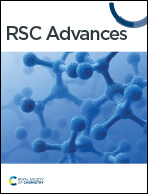Coaxial nickel cobalt selenide/nitrogen-doped carbon nanotube array as a three-dimensional self-supported electrode for electrochemical energy storage†
Abstract
Herein, we propose a one-step urea pyrolysis method for preparing a nitrogen-doped carbon nanotube array grown on carbon fiber paper, which is demonstrated as a three-dimensional scaffold for constructing a nickel cobalt selenide-based coaxial array structure. Thanks to the large surface area, interconnected porous structure, high mass loading, as well as fast electron/ion transport pathway of the coaxial array structure, the nickel cobalt selenide/nitrogen-doped carbon nanotube electrode exhibits over 7 times higher areal capacity than that directly grown on carbon fiber paper, and better rate capability. The cell assembled by a nickel cobalt selenide/nitrogen-doped carbon nanotube positive electrode and an iron oxyhydroxide/nitrogen-doped carbon nanotube negative electrode delivers a volumetric capacity of up to 22.5 C cm−3 (6.2 mA h cm−3) at 4 mA cm−2 and retains around 86% of the initial capacity even after 10 000 cycles at 10 mA cm−2. A volumetric energy density of up to 4.9 mW h cm−3 and a maximum power density of 208.1 mW cm−3 are achieved, and is comparable to, if not better than, those of similar energy storage devices reported previously.



 Please wait while we load your content...
Please wait while we load your content...